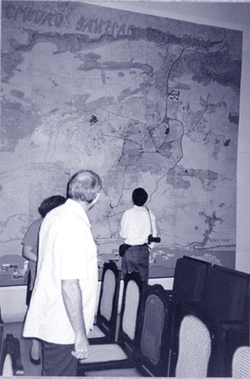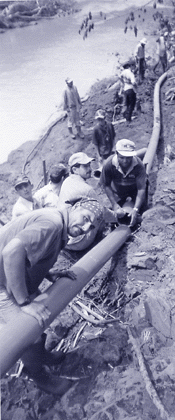|
Guidelines
for National Platforms for Disaster Reduction
Background
 Throughout
the IDNDR, and particularly in recent years, IDNDR National Committees
and Focal Points proved to be key organizational mechanisms in many countries
to expand the understanding and perceptions of disaster reduction and
to increase the opportunities for association of diverse professional
interests committed to the subject. In more than 130 countries a combination
of representatives drawn from positions in government, professional disciplines,
and local leadership were encouraged to address collectively such matters
as public information and education, the conduct of hazard and risk assessments,
national planning initiatives, or community forms of mobilization for
disaster reduction. This momentum should be maintained, and even increased
in response to the needs of hazards and risks in the 21st century. Throughout
the IDNDR, and particularly in recent years, IDNDR National Committees
and Focal Points proved to be key organizational mechanisms in many countries
to expand the understanding and perceptions of disaster reduction and
to increase the opportunities for association of diverse professional
interests committed to the subject. In more than 130 countries a combination
of representatives drawn from positions in government, professional disciplines,
and local leadership were encouraged to address collectively such matters
as public information and education, the conduct of hazard and risk assessments,
national planning initiatives, or community forms of mobilization for
disaster reduction. This momentum should be maintained, and even increased
in response to the needs of hazards and risks in the 21st century.
Proceeding from a
greater awareness of the risks that natural, technological and environmental
risks pose to modern societies, the International Strategy for Disaster
Reduction provides an important opportunity to review, consider and re-commit
appropriate forms of national and local platforms for disaster reduction.
IDNDR has demonstrated that while there is no exact standard that is suitable
for the needs and relative interests, or cultural values, of all countries,
there has been a clear recognition of value in the official commitment
and encouragement of some form of guiding or coordinating body to link
the many interests vital for successful accomplishments in disaster reduction.
The ISDR framework should strive to develop even further the basic principles
of multi-disciplinary and inter-sectoral involvement, engaging both officials
responsible for policy as well as public representatives essential for
widespread participation. Equally important, is the engagement of an increasingly
wide range of professional involvement, skills, and abilities, that are
essential for a comprehensive and sustained approach to a truly national
commitment to disaster reduction.
Suggested Guidelines for National Platforms for Disaster Reduction
The following guidelines
are presented for consideration, and encouraged use through the actions
of ISDR Inter-Agency Task Force member organizations, and within individual
countries. To the extent that they may prove feasible, they may also usefully
inform similar collective platforms within local communities, or in a
regional or sub-regional context. Their overall intention is to encourage
an expanded awareness, understanding and commitment for all members of
a society or a community exposed to the risks of hazards where they live
and work – and their respective roles and responsibilities of working
together to build disaster-resilient communities.
 Official governmental support and evident encouragement at all appropriate
levels of authority is essential for successful National Platforms.
Official governmental support and evident encouragement at all appropriate
levels of authority is essential for successful National Platforms.- National Platforms
should be comprised in a bi-partisan, non-political basis – with
the expectation that their value serves the community at large, and
increases in value over time.
- An informed and
involved public, motivated to participate in all aspects of hazard and
risk management for disaster reduction, provides a necessary basis for
effective platforms.
- National platforms
should be conceived and maintained with a broad and transparent purpose
in addressing the needs, and preserving the social and economic assets,
of the community.
- National platforms
may strive to represent a broad community of interests, that encompasses
public policy issues; governmental authority; technical and professional
abilities; financial and commercial interests; media access and involvement;
educational processes; civic, non-governmental and local leadership;
and specialized, skilled, or social abilities and within a community
associated with the well-being and sustained livelihoods of its members.
- While distinctive
in their technical abilities, specialized services associated with emergency
assistance requirements, need to be fully included in the broad community
of interests associated with National Platforms.
- National Platforms
should be encouraged to develop and maintain public information and/or
professional exchange networks both for its immediate national and local
constituencies, as well as with the larger external, international,
and regional/sub-regional collaborators in disaster reduction issues.
- National Platforms
need to be sensitive to dynamic changes in demographics, land use, community
growth and environmental conditions or resource utilization.
- Shared resource
allocations and commitments, or a broadly-based means for ensuring sustainability,
viability, and productivity are essential.
- National Platforms
should strive to possess the professional legitimacy and authority to
represent the interests, or speak on behalf of the country – as
well as to extend, share, and communicate the efforts, interests and
concerns of the communities concerned in matters of hazards and risk
reduction activities.
- National Platforms
may seek to become active within international and regional/sub-regional
contexts, both to provide as well as receive the benefits of shared
information and experience related to disaster reduction.
Overall, with recognized
authority and professional integrity, National Platforms should strive
to be inclusive, and seek to motivate, all political, social, and economic
interests within a community - for the commonly agreed purpose of protecting
the social resources, economic assets, basis of livelihoods, and environmental
conditions of all inhabitants from avoidable loss or damage associated
with hazards. Synergy is a hallmark of effective platforms – and
widespread participation is a measure both of understanding, and essential
support.
For more information, contact:
isdr@un.org
|




